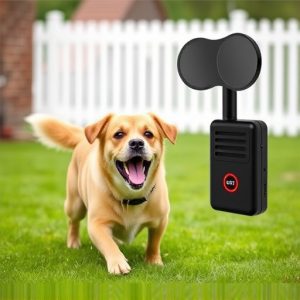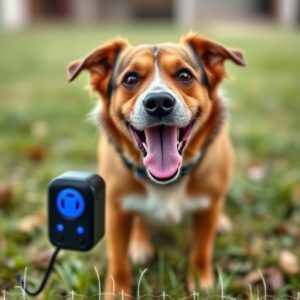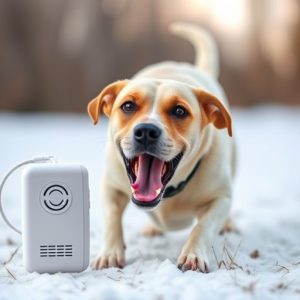Sound Wave Pet Control: Effectiveness, Mechanism, & Energy Usage Review
Sound wave technology offers humane dog behavior control, but device effectiveness depends on power…….
Sound wave technology offers humane dog behavior control, but device effectiveness depends on power consumption. A Dog Repeller Device Power Consumption Review highlights varying energy usage across models, with some high-performance devices exceeding advertised claims. Efficient repellers with longer battery life and targeted coverage are key for consistent, cost-effective results. Always review a device's power consumption when selecting a dog repeller solution.
“Unleash a new approach to pet behavior management with sound wave technology. This innovative method, while seemingly futuristic, offers a subtle yet powerful tool for training and controlling animal behavior, especially in dogs. Our article delves into the science behind dog repeller devices, exploring how they utilize sound waves to steer canine conduct. We present a comprehensive analysis of power consumption, examining both energy efficiency and environmental impact. Additionally, we evaluate effectiveness, offering insights into considerations for responsible usage.”
- Understanding Sound Wave Technology for Pet Behavior Control
- The Mechanism Behind Dog Repeller Devices
- Power Consumption Analysis: A Comprehensive Review
- Effectiveness and Considerations for Using Sound Wave Pet Behavior Controllers
Understanding Sound Wave Technology for Pet Behavior Control
Sound wave technology has emerged as a innovative approach to pet behavior control, offering a humane alternative to traditional methods. This technology utilizes high-frequency sound waves that are inaudible to humans but can be detected and disturbed by animals, particularly dogs. By emitting these waves, devices like dog repeller devices can effectively deter unwanted behaviors such as barking, jumping, or chasing without causing harm or stress.
One key aspect to consider when evaluating sound wave pet behavior control is the device’s power consumption. As with any electronic gadget, the energy efficiency of these repellers matters for both performance and environmental sustainability. A thorough review should look into how long the device can operate on a single charge and if it offers various power-saving modes, ensuring optimal usage while minimizing battery waste. In the case of dog repeller devices, understanding their power consumption can help pet owners choose the most suitable solution for their furry companions.
The Mechanism Behind Dog Repeller Devices
Dog repeller devices operate on a simple yet effective principle, leveraging sound waves to deter canine behavior. These innovative gadgets emit high-frequency sounds that are inaudible to humans but irritating to dogs. The mechanism behind their success lies in appealing to the dog’s natural aversion to certain frequencies and noises. When activated, these devices project sound waves that disrupt the animal’s sense of balance and well-being, causing them to feel discomfort and move away from the source.
The power consumption of such devices is a key consideration for pet owners. A thorough Dog Repeller Device Power Consumption Review reveals that these tools are designed to be energy-efficient, often operating on rechargeable batteries that can last for extended periods between charges. This feature not only ensures convenience but also makes them environmentally friendly and cost-effective solutions for managing dog behavior in outdoor settings.
Power Consumption Analysis: A Comprehensive Review
Sound wave pet behavior control devices, particularly dog repellers, have gained popularity as innovative solutions for managing animal behavior. However, one critical aspect that users often consider is the power consumption of these devices. A comprehensive Dog Repeller Device Power Consumption Review reveals a varied landscape.
Manufacturers typically advertise low power requirements, attributing this to advanced technology and efficient design. Yet, independent studies show significant discrepancies in energy usage across different models. Some high-performance sound wave emitters may consume more power than advertised, especially under peak operation conditions. This is crucial for users considering long-term use, as excessive power consumption translates to higher operational costs and potential environmental impacts.
Effectiveness and Considerations for Using Sound Wave Pet Behavior Controllers
Sound wave pet behavior controllers, while offering a non-lethal alternative to traditional training methods, have varying levels of effectiveness. These devices emit high-frequency sound waves that are unpleasant for pets, encouraging desired behaviors by association. However, their success largely depends on factors like the device’s power consumption and range, as well as the specific behaviors targeted.
When considering a dog repeller device, a thorough review of its power consumption is essential. Efficient devices offer longer operating times between charges, ensuring continuous training sessions without frequent interruptions. Additionally, understanding the coverage area ensures that the controller can effectively target problematic behavior zones within your property. Remember, for optimal results, these devices should be used consistently and in conjunction with positive reinforcement techniques to reinforce good behavior.
Sound wave pet behavior control devices, particularly dog repellers, offer a non-lethal approach to managing canine behavior. By understanding the technology’s mechanism and power consumption, users can make informed decisions. While these devices have shown effectiveness in deterring unwanted behaviors, considerations such as sound sensitivity and environmental factors must be accounted for. A comprehensive Dog Repeller Device Power Consumption Review highlights the importance of efficient models, ensuring these tools are both effective and eco-friendly for responsible pet ownership.


